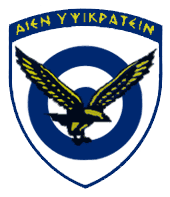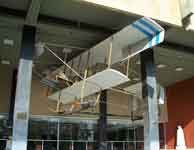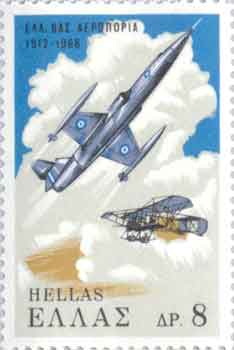|
|
"Always Dominate the Heights" The Hellenic Air Force (Greek Πολεμική Αεροπορία) is the primary air force of Greece.
History See main article: History of the Hellenic Air Force
The first Aviation Service was established in 1911, with help from French experts. Six Greek officers were sent to France for training, while the first four "Farman"-type aircraft were ordered. The first Greek aviator was Emmanuel Argyropoulos, who flew in a Nieuport IV.G "Alcuin" fighter, on February 8, 1912. The first military flight was made on 13 May of that year by Lieutenant Demetrios Kamberos. In June, Kamberos, flew with the "Daedalus", a "Farman" aircraft that had been converted into a seaplane, setting the foundations of the Naval Aviation. That September, the Greek Army fielded its first squadron, the Aviators Company (Λόχος Αεροπόρων). The Hellenic Air Force participated in the Balkan Wars, World War I, the Asia Minor Campaign, and World War II. Initially it consisted of the separate Army Aviation and Naval Aviation, but in 1930 the Aviation Ministry was founded, establishing the Air Force as the third branch of the Hellenic Armed Forces. In 1931, the Air Force Academy, the Scholi Ikaron was founded. During the Second World War, it successfully resisted the Italian invasion in 1940, but practically the entire force was destroyed by the Germans in April 1941. The Air Force was rebuilt in the Middle East as part of the Royal Air Force, flying Spitfires,Hurricanes and Baltimores. After Greece's liberation in 1944, it returned home and subsequently participated in the Greek Civil War.
In the 1950s, the force was rebuilt and organized according to NATO standards. The Greek Air Force participated in the Korean War with a transport flight. Greece participated in NATO nuclear weapons sharing until 2001, using A-7 Corsair IIs to deploy U.S. tactical B61 nuclear bombs from Araxos Air Base. Until the late 1980s the Air Force deployed Nike-Hercules Missiles armed with U.S. nuclear warheads. As a result of Greco-Turkish tensions around the 1974 turkish invasion in Cyprus, the U.S. removed its nuclear weapons from Greek and Turkish alert units to storage. Greece saw this as another pro-Turkish move by NATO and withdrew its forces from NATO’s military command structure from 1974 to 1980.
Organization See main article: Structure of the Hellenic Air Force The Hellenic Air Force is overseen by the Greek Ministry of Defence, whose current head is Vangelis Meimarakis. Combat operations are overseen by a Chief of Operations, while support services are managed by the Directorate of Aeronautical Support, with the training squadrons and schools run by the Training Directorate.
Equipment See: List of Hellenic Air Force aircraft Combat aircraft flown by the Hellenic Air Force include a number of advanced foreign fighters (F-16C/D block 30,40,50 and 52+, Mirage 2000 and 2000-5) with older models retrofitted to the latest standards. The main transport utilized is the C-130 Hercules. On June, 2005, the Hellenic Ministry of Defence announced a 1.1 billion $ agreement for the commission of further 30 (with an option for 10 more) F-16C/D block 52+ which will be delivered until 2009.
See Image of Tatoi Airport from Space Link
Military of Greece Hellenic Navy | Hellenic Army | Hellenic Air Force Retrieved from "http://en.wikipedia.org"
 |
|
|||||||||||||||||


